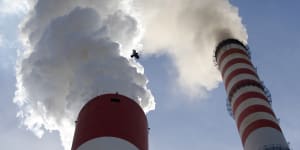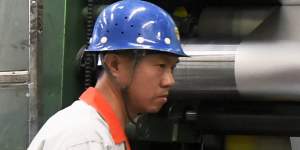The agreement they struck was to restrict access to their markets for “dirty” – carbon-intensive – and dumped steel and aluminium and to encourage domestic production of “green” metals.

If the other major economies do introduce C-BAMs,of course,Australia will have little choice but to introduce both an explicit carbon price and a carbon border tax of our own or risk both being shut out of key markets and becoming a dumping ground for carbon-intensive products.AP
Given that China produces about 60 per cent of the world’s steel and is regularly accused of dumping subsidised metal into the international market,the measures are clearly and squarely aimed at its exports.
They go,however,well beyond conventional anti-dumping actions,or old-fashioned protectionism to create an alliance (albeit at this point a narrow one) between two of the world’s three largest economies and markets to address carbon intensity within and beyond their borders,using trade policies as their lever.
The agreement sits neatly within the framework of CBAM,which would impose taxes at the EU’s borders on imports from countries with lesser emissions targets and carbon prices than the EU.
That proposal has been controversial because it is protectionist,albeit that its philosophy is to protect European industries confronted with tough emissions standards and high prices/taxes on their emissions from suffering competitive disadvantage from countries with lower (or non-existent) carbon prices.
It would also do away with the incentive for European companies to import rather than produce locally or to shift their production to jurisdictions with weaker and cheaper emissions standards,both moves that undermine global efforts to reduce emissions. It’s protectionism with a moral dimension.
The interesting aspect of the agreement on steel and aluminium is that the US decision to sign up to it doesn’t appear to have sparked any great controversy in the US. Indeed,the US steel sector has generally welcomed it.
The Democrats,of course,have proposed a version of C-BAM,a “polluter import fee”,and have also shown some enthusiasm for a fully-fledged carbon border adjustment mechanism of their own.
Within Joe Biden’s proposed $US1.75 trillion ($2.4 trillion) of social spending and tax increases there is also a plan to impose a domestic levy of almost $US20 a tonne on carbon. While that’s less than a third of the EU’s carbon price,it would increase over time.
If the proposal is to succeed and win the support of the affected industries – and the Republicans – it is inevitable that it would have to include an extra-territorial dimension. It would have to look like the C-BAM.
China’s acutely aware of the risks to its economy of the increased focus on carbon emissions and the wider interest in carbon border taxes. Its current energy crisis – and its scramble to produced or buy more coal and gas – is partly attributable to an overly zealous crackdown on its most carbon-intensive sectors.
The US steel sector is enthusiastic about the deal struck by the US and EU because about 70 per cent of US steel is produced by electric arc furnaces using recycled metal. It is far less carbon-intensive than the steel produced in the coal-fired blast furnaces that dominate China’s production.
US industry generally – and the same could be said of industries in other developed economies – is less carbon-intensive than in China and other less-developed economies. That explains why countries like Japan and South Korea – along with more obvious candidates like Britain and Canada – are also actively exploring the concept.
Even in much-maligned Australia,most large companies – particularly those in the more carbon-intensive sectors – have,or are developing,internal carbon prices against which to assess their operations and future investments. Most are fast-forwarding plans to have net zero emissions by 2050,if not before.
If the other major economies do introduce C-BAMs,of course,we’ll have little choice but to introduce both an explicit carbon price and a carbon border tax of our own or risk both being shut out of key markets and becoming a dumping ground for carbon-intensive products.

China has long been accused of dumping subsidised metal into the international market.AP
The US-EU deal envisages a technical working group using the next two years to develop methods and data to calculate the embedded emissions in traded steel and aluminium,with their work finalised broadly in time for the 2023 launch of the EU’s C-BAM pilot.
That pilot phase,also two years,will cover the iron steel,aluminium,cement and fertiliser industries before being expanded post-2025 to a wider range of activities.
China’s acutely aware of the risks to its economy of the increased focus on carbon emissions and the wider interest in carbon border taxes. – and its scramble to produce or buy more coal and gas – is partly attributable to an overly zealous crackdown on its most carbon-intensive sectors.
It launched a carbon market of its own mid-year,albeit “only” covering its power generation sector (which accounts for about 40 per cent of its total emissions). Trading in these carbon credits has been thin and the prices a fraction of those in other carbon markets,generally in the single digits. It is,of course,early days and the volumes and prices are expected to rise over time.
The EU’s C-BAM would be a very complex tax regime and one that would be even more difficult for companies in countries that don’t have explicit carbon taxes or cap-and-trade schemes. It would also,unless they were excluded,punish the developing world.
One of the under-appreciated aspects of the carbon pricing and emissions reduction debates is that a combination of carbon pricing and carbon border taxes would favour the developed world because its industries are already more carbon-efficient and they,and their governments,also have greater financial and technical capacity to underwrite the transitions to economies with lower emissions-intensity.
The EU/US steel and aluminium deal,for instance,is seen as providing US exporters with a significant competitive advantage over existing suppliers to Europe such as Russia,Ukraine and Turkey.
There’s a lot of opportunity,as well as threats,as the developed world moves,albeit slowly and in some cases very reluctantly,towards meaningful emissions reductions. Even the world’s second-largest polluter – the US – seems now to be pursuing the opportunities rather than being paralysed by the threats.
The Market Recap newsletter is a wrap of the day’s trading..